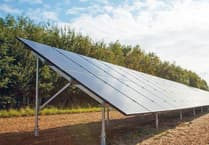Plans for a solar farm could be approved to help the University of Surrey meet its net zero carbon emission targets. The university has said the proposal is a “key element” of its strategy to achieve carbon neutrality by 2030.
The joint-application, between the university and SSE Energy Solutions, proposes a new solar energy facility on 43 hectares of fields, on land west of Blackwell Farm, Hogs Back. Members on Guildford Borough Council’s planning committee will decide on the revised application, submitted earlier this year, which has a new vehicle access route.
Part of the university’s estate, the land is also Green Belt and an Area of Great Landscape Value (AGLV).Only used for 35 years, the applicants state the land would be restored to its previous condition and use when the solar panels and equipment are cleared.
If approved, the site would see the installation of a 12.21 MegaWatt solar farm on 35 hectares, compromising a system of solar panels installed on the ground to generate renewable energy. Adding to the existing solar capture systems on the university’s buildings, the new development is said to “help achieve a significant uplift” in providing solar energy according to planning documents.
Around 22,410 solar panels could be installed on the site, providing electricity directly to the university by a cable link to a substation on the Stag Hill campus. Gaps of up to 5.3 metres will be between each row, the planning documents state, allowing for the grassland to grow and sheep to graze during the operational period.
Students at the university have rallied around in support of the proposal. The Students’ Union (SU) has submitted a letter of support for the application, arguing: “Sustainability is no longer seen as a ‘nice to have’ but an integral part of the university’s long-term strategy across all operations – from student accommodation to teaching and research facilities.”
But the application has received some backlash, with over 100 residents objecting to the solar farm and at least 15 groups and organisations.
Guildford Residents Association has expressed concern that the proposed development could have an “urbanising effect” on green belt land. The Guildford Society has also called the application “premature” as part of the site covers an area in the Surrey Hills National Landscape boundary review by Natural England.
Objectors have also argued the university should incorporate more solar panels on its existing infrastructure and car parks. But the applicants claim these could only be delivered on a “piecemeal basis” over a period of years and the solar panels would not create enough zero carbon electricity that the proposed solar facility can do.
Worplesdon, Wanborough and Compton parish councils have opposed the application, raising concerns about potential harm to wildlife and habitats, agricultural land and the countryside.
Planning documents state that the proposed development would “not lead to the permanent loss of agricultural land” as the fields would continue to be used for sheep grazing. The applicant claims that the soil quality would be maintained and could be improved as the land lies unproductive for a time.
Recommended for approval subject to conditions, the application will be decided by Guildford Borough Council planning committee on November 6.






